© 2022 All rights reserved Worktop Library
These are two of the most popular materials for kitchen worktops, but both have their own drawbacks of marble and quartzite you must be aware of them before making your final decision.
- Why Marble and Quartzite are two of the most popular materials for kitchen worktops
- Learn about the pros and cons of new natural Marble, Quartzite and Quartz as kitchen worktops
- Differences between Marble, Quartzite and Quartz
- Discover more about the trending Marble and Quartzite materials. Read our entire article section on this topic!
- Conclusion
Why Marble and Quartzite are two of the most popular materials for kitchen worktops
More recently, marble and quartzite worktops are increasingly prevalent in homes, bars and restaurants across the capital. It is because they are more beautiful than any artificial material, more durable (when you maintain them minimally), and more attractive. Moreover, these natural stone worktops can last over a century with proper maintenance.
Durability
The durability of a quartzite or marble countertop is unquestionable. Both materials are extremely tough and long-lasting. If you don’t use them in an environment where they are routinely exposed to high heat, or if they don’t cause accidental impact with another hard surface, they will last for decades.
When you walk around central London, you can see many monuments made from marble. Just look at Marble Arch.
London, England’s Marble Arch, is a white marble ceremonial arch created by John Nash in 1827 to serve as the official entrance to Buckingham Palace. Almost 200 years after its installation is still standing strong in London W1.
Long Term Value
In addition to durability, quartzite worktops (or marble worktops, for the same matter) provide homes with lasting value. Not only will your home look unique when you install a quartzite countertop, but it will also hold or increase its overall value.
It is because, just like gold, one famous mineral we all know, there is a certain amount of stone on the planet. Therefore natural marble and quartzite do hold value over time. Similarly, both materials provide a luxurious decorative setting upscaling the overall property specification on which you install them.
Unique Aesthetics
Regarding aesthetics, when it comes to their patterns, both marble and quartzite are better options than engineered quartz. Why? You may ask. -Take White Carrara marble. The grey veins of White Carrara marble are a characteristic feature of this stone. It is the same in quartzite. For example, Taj Mahal quartzite has its very own pattern of semi-translucent veins. As a result, quartzite and marble are more individualistic than quartz, for instance.
Now, let’s compare the looks of materials with bold veins. Calacatta marble is one of London’s most popular types, mainly used for creating high-end kitchens and bathrooms.
Calacatta Gold marble is a stunning natural stone perfect for creating luxurious and sophisticated designs. This beautiful marble displays grey veins with golden hints, adding a touch of elegance to any space. It is ideal for kitchen worktops, bathroom vanities, flooring, and other design projects.
Its colour varies from light beige to grey with small veins, and it’s often prevalent in living rooms and large halls.
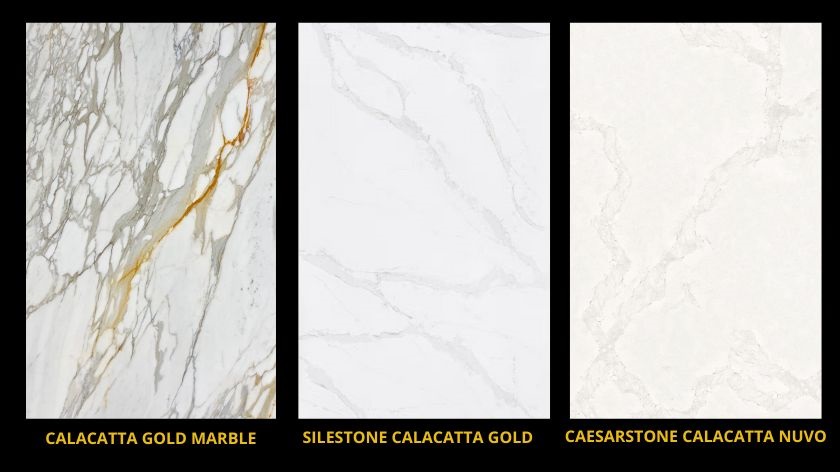
Pros and cons of Marble and Quartzite as kitchen worktops
Above, we discussed two pros of marble and quartzite worktops: they are durable and offer fantastic value over time. But what about their cons?
Drawbacks of marble and quartzite: Performance
Regarding performance, quartz is a much better option than quartzite and marble because it’s generally cheaper, more practical and easier to maintain. In addition, a quartz worktop does not require mild cleaners.
Although porosity is not one of the significant drawbacks of marble and quartzite as kitchen worktops due to their low absorption levels, quartz is more practical. Moreover, you can use any detergent you find in the house to clean the quartz worktop’s surface.
And because quartz is 100% non-absorbent, you will never require to apply sealants on the worktops. Where marble and quartzite surpass engineered quartz outdoors. It is because prolonged exposure to sunrays doesn’t affect the natural stones as it does quartz.
The below chart shows the key performance metrics of five typical types of materials:
Porosity
| TYPE OF STONE | Porosity ( % per Kg) |
|---|---|
| White Carrara marble | 0.10% |
| Nero Marquina marble | 0.18% |
| Bianco Eclipse Quartzite | 0.9% |
| White Macaubas quartzite | 0.4% |
| Taj Mahal quartzite | 0.26% |
| Engineered quartz | 0.07% |
Without being a stone expert, you can quickly determine whether stones are porous by throwing water on a sample that isn’t sealed and observing whether it absorbs it and how long it may take for the water to soak into the sample.
Hardness
| TYPE OF STONE | Moh’s Scale Hardness (1-10) |
|---|---|
| White Carrara marble | 3 |
| Nero Marquina marble | 3 |
| Bianco Eclipse Quartzite | 7 |
| White Macaubas quartzite | 6 |
| Taj Mahal quartzite | 6.5 |
| Engineered quartz | 6.5 |
Density
We would only consider the density of stones as one of the drawbacks of marble and quartzite as kitchen worktops when taking into account it makes them longer to fabricate, which translates into higher costs. Other than this, density is an advantage for accidental knocks.
| STONE TYPE | DENSITY (Kg/m3) |
|---|---|
| Bianco Carrara marble | 2710 |
| Marquina marble | 2680 |
| Bianco Eclipse quartzite | 2700 |
| White Macaubas quartzite | 2646 |
| Taj Mahal quartzite | 2610 |
| Engineered quartz | 2100 |
Differences between Marble, Quartzite and Quartz.
Do you see the correlation between the comparison photos of both White Carrara marble and Calacatta Gold marble against the quartz alternatives? Do you see something in common?
Well, if you have not yet noticed, there is a visual difference in the structure of their veins. Whilst the natural marble veins create a solid imprint on the surface, the veins on the quartz slabs seem somewhat like pixels when you look at them closely.
It is because even though the body and composition of the leading quartz brands comprise a minimum of 90% natural quartz, they contain a tiny element of polymers and coloured resins that provides them with different patterns and shading.
Manufacturers must use precise formulas for their products to achieve a duplicate as close to the authentic marble veins. For example, too much colouring can result in bulky and dense looks becoming somewhat burdensome on the design.
It is one of the significant reasons why marble looks much more natural and genuine compared to quartz. That said, on close inspection, you can quickly tell there is a considerable difference between marble and quartz.
Quartz and Marble Worktops Feel the Same at Touch
Samantha is a London homeowner that got in touch with us recently as she wanted to know the real difference between a marble worktop and a similar quartz version. She told us:
‘The first time I tried a quartz worktop was in a showroom. It felt pretty much the same as the marble one next to it. You probably couldn’t tell the differences if you didn’t know. The only difference is the colour, which you can customise to your taste. The striking colours, such as Statuario quartz or Calacatta, are a bit more expensive than other materials, but it s worth it if you’re looking for a high-end feel.’
As we mentioned, you cannot tell the difference between quartz and marble when touching both materials. It is because both materials comprise natural minerals. In the case of marble, it shall consist of 100% natural minerals. Conversely, a high-quality quartz worktop includes more than 90% natural minerals.
What is the difference between a Quartz surface and Natural Quartzite?
Quartzite is a non-crystalline, sedimentary rock that was originally sandstone. Quartzite comprises mainly natural quartz (silicon dioxide), feldspar and mica.
And quartzite worktops are increasingly popular in London homes because they produce stunning veins similar to marble (and, in many cases, more spectacular).
At the same time, natural quartzite does not contain the calcium you find in marble. Therefore, you cannot etch a quartzite worktop when exposed to acids from fruits and juice.
If you cut a lemon (or orange) in half and leave it on your marble worktops overnight, you may find it burns its surface, leaving a distinctive imprint from the lemon on the surface. In contrast, such an exercise would not affect the quartzite’s surface. So rather than being one of the drawbacks of marble and quartzite, etching only applies to marble.
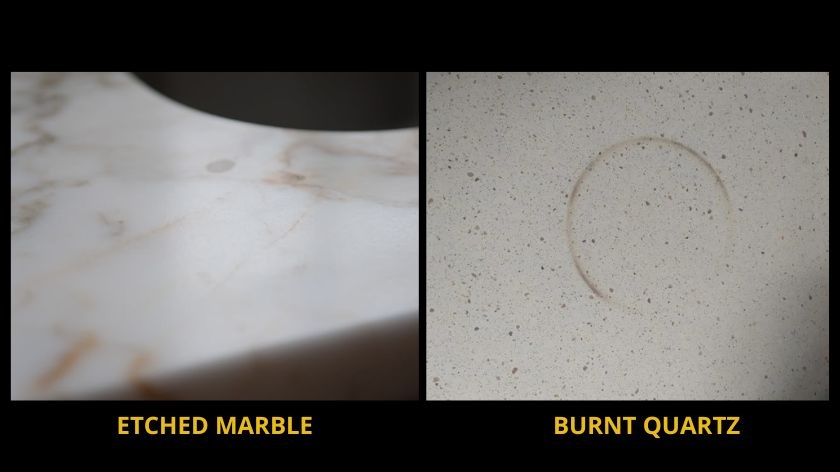
You must always check that your worktops are quartzite and not marble. It is because many companies re-brand and rename marble slabs as quartzite for commercial purposes, resulting in poor experiences for some. The best way to check that your quartzite worktops aren’t, in reality, marble is to ask a worktop supplier with experience working with exotic natural stones from around the globe.
For example, many popular quartzite stones, such as Bianco Eclipse and White Macaubas quartzite, come from Brazil, so London worktop suppliers with a network of contacts and distributors in places like South America are an excellent place to start.
Usability
Regarding usability, quartz is a clear winner compared to marble and natural quartzite.
First, you can choose quartz worktops from standardised slab sizes. It means you can work on small and large-scale projects with consistency and continuity between the spaces. In addition, by working with identical slab sizes, you can make precise calculations that avoid wasting material resulting in cost savings too.
Second, because quartz is engineered, it is non-porous. As a result, quartz worktops don’t need sealants, protective coatings or waxes to keep them looking new. This fact alone will save you approximately 30 hours of cleaning time over a year.
Third, marble and quartzite need ph neutral cleaners first, and then you must rinse them with water to remove the cleaning solution.
In contrast, you can clean a quartz worktop effortlessly by using Windowlene or similar household cleansers. In addition, the non-absorbency of quartz worktops ensures that they remain germ-free, always. Nothing can get into its pores because there are no pores in quartz! Quartz is the way to go if you are looking for hygienic and time-saving surfaces.
Another advantage of quartz over marble, particularly quartzite, is that it is easy to cut and install.
Whilst offering the same strength as quartzite, the composition of a quartz slab makes it easier to cut.
It means you can shape it into anything and design intricate worktop edges. In contrast, quartzite is very tough to cut, resulting in longer fabrication times (it takes twice as long to cut quartzite as it does to cut marble or quartz), resulting in higher labour and installation costs.
Note: Remember that quartz’s usability only applies to interior spaces. Because most quartz worktops contain a small percentage of polymer resins, they can alter their colour when exposed to sunlight. However, we are not discussing worktops next to a window in the kitchen. Instead, we are talking about installing your kitchen worktops outdoors.
If you were to install a standard white quartz kitchen worktop in the garden, you might find that it has become almost yellow over time. It is because the sun ‘tans’ the resins in variations from white to yellow, red to orange, etc.
Quartz Vs Quartzite Vs Marble Prices
Because of the inflationary pressures in 2022 and 2023, we will provide you with price ranges instead of actual per-square-meter prices. It will enable you to make a price differentiation regardless of whether a specific quartzite, marble or quartz material changes in price.
For example, if marble price increases in your area, you will be able to see that it has increased and will adjust your prices accordingly.
Additionally, you can install marble or quartz worktops in a matter of hours, making them a good choice if you work to a deadline. In contrast, quartzite is heavier and more prone to chipping on intricate edges, making its installation longer, which results in higher installation costs than the other two stones.
Marble Prices – How Much Does Marble Cost?
A little unknown fact: marble is one of the most affordable stone worktops. As long as you don’t go overboard with exotic marble, it should be easy to find something that fits your budget.
For example, White Carrara marble, the most popular amongst designers and architects, starts at £140 per square metre in 2 cm thickness, including Vat. Similarly, a Nero Marquina marble surface in 2 cm thickness costs £115 per square metre, including Vat.
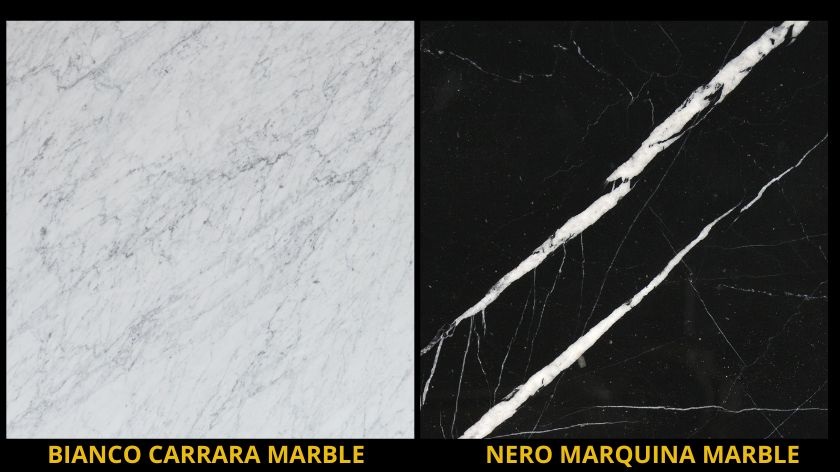
Quartzite Prices – How Much Does Quartzite Cost?
Quartzite is a popular material for kitchen worktops and bathroom walls. However, it is more expensive than quartz, marble or even granite. The reason for its higher cost is scarcity. Like our previous example of gold and marble as minerals, quartzite prices vary by the same principles. In addition, scarcity means quarries must operate in remote places or at high altitudes to extract quartzite, translating into higher overall prices.
However, the uniqueness and beauty of quartzite make it worth the price. Not only a quartzite countertop is aesthetically pleasing, but it is a durable and easy-to-maintain material. For instance, quartzite offers up to 650 Celsius resistance to heat and stains (compared to 150 Celsius in quartz and 350 Celsius in marble), and you can clean it easily with water and mild detergent.
Quartzite prices: White Macaubas quartzite, one of the most popular white natural stone worktops, start at £265 per square metre in 2cm thickness. Moreover, the most exotic types carry higher prices. For example, Patagonia quartzite costs £620 per square metre.
Besides the per square metre price alone, you must consider that the quartzite fabrication and installation are higher than that of marble and quartz. These two materials are less rigid and, therefore, less prone to cracking when serious accidents happen.
PERSA GREEN QUARTZITE WALL CLADDING PHOTO
Quartz Prices: How Much Does Quartz Cost?
Quartz prices vary according to the quality and minerals that comprise it. Otherwise, how can a quartz slab from China cost less than one from Europe despite its higher transport costs? It happens because the material will be of inferior quality.
Low-quality quartz worktops mean more resins and less natural quartz content. In addition, it results in white quartz that can turn yellow quickly or in high rates of respirable silica, which is related to silicosis.
Leading brands have re-formulated their quartz surfaces into hybrid quartz products that don’t contain hazardous levels of silica. Some examples are Silestone HybriQ and HybriQ+, and Compac Quartz IQ, and IQ Pro Circular science. These quartz products from two major players in the quartz manufacturing arena are safe and environmentally friendly.
Quartz prices from leading brands start at £163 per square metre in 2cm thickness, including Vat for colours such as Silestone Gris Expo and Silestone Marengo. Similarly, Compac Ceniza and Compac Plomo quartz prices are £149 per square metre in 2cm thickness.
If you have a strict budget and are looking for alternative quartz brands for worktops, unbranded quartz prices start at as low as £125 in colours such as Brilliant Grey, pure white quartz or pure black.
The primary consideration with the cheaper quartz surfaces is to talk to your worktop supplier and ask them how long they have been fabricating the product. Their answer will tell you whether they had any issues with fabrication, installation, or discolouration of the surface.
You will be surprised to learn that many Asian quartz worktop alternatives can be almost as good as the ones from leading brands. In addition, you may know that many stone suppliers have been installing them for decades with no performance or safety issues.
Trending Marble and Quartzite materials as kitchen worktops.
If you are looking for popular quartzite worktops and marble surfaces, you are in the right place.
With over 7,500 worktop installations in London and the South of England, The Worktop Library is a benchmark for trending worktop materials. In addition, the company carries out home and business projects across the capital and surrounding counties, giving them data on the latest worktop installations.
So, what worktop materials are trending at the end of 2022 and into 2023? Keep reading to see the list.
Dover White Quartzite
It is also known as Oyster White quartzite, Atlantic White quartzite, or even Dover White granite, which is, by far, one of our most exquisite premium stones. The mix of flowing patterns that emerge in colourful and distinctive shapes in each piece of this beautiful Brazilian stone is by far its most remarkable uniqueness. Moreover, it may give you the impression that you are facing a marble cloud because of the constant but erratic movement of grey and off-white shading.
- Thicknesses:2cm / 3 cm
- Finishes: Polished / Honed
- M2 Price:£235 in 2cm / £280 in 3cm
Calacatta Lincoln Marble
It is a white stone displaying a smokey grey overlay on a white backdrop. The veining is exquisite and exhibits a lovely greyish hue that sometimes changes to silvery. Calacatta Lincoln marble worktops are prevalent in spaces requiring striking patterns but without overpowering the room’s overall design.
- Thicknesses: 2cm / 3 cm
- Finishes: Polished / Honed
- Prices: M2 Price: ;£699 in 2cm / £815in 3cm
If you love the look of this marble but find it expensive for your project, you may be interested in a sintered stone alternative known as Infinity Calacatta Lincoln.
Blue Quartzite: natural blue-coloured stones are trending, and the more exotic, the better. Some of the latest blue worktop materials are Explosion Blue quartzite, Fusion Blue, and Cayman Blue marble. Note that these aren’t cheap, but they are worth the cost as they provide a unique ambience and last for decades. For example, the square metre price of Explosion Blue quartzite in 2 cm thickness starts at £490, including Vat.
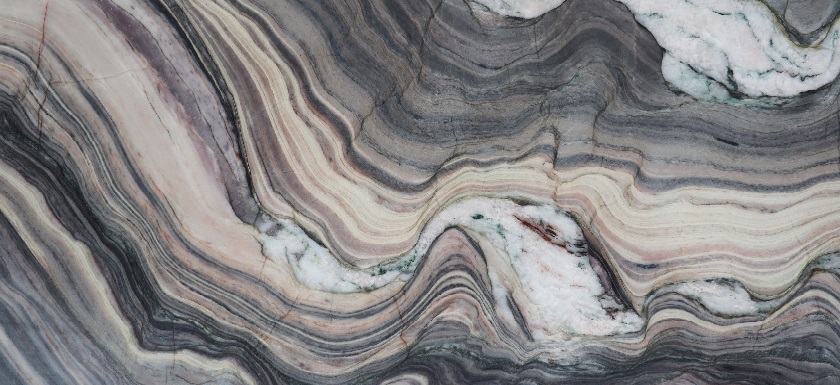
Calacatta Marble is a classic stone for luxurious settings and is rediscovered by quarries in new variations that continue coming into 2023. Some of the most prevalent variations of this stone are Calacatta Bettogli and Calacatta Borghini marble. Historically speaking, the names of these materials follow the surnames of the Italian families that own these quarries.
Calacatta Bettogli marble
Another beautiful and highly coveted marble from Carrara is Calacatta Bettogli, which features striking veining and an ivory-white backdrop with light grey to pale beige. You can use this white and gold marble in various settings, including kitchens, bathrooms, living rooms, etc. Calacatta Bettogli is a fine white marble that will make for a striking focal point in any space.
- Thicknesses: 2cm / 3 cm
- Finishes: Polished / Honed
- M2 Price: £1100 in 2cm / £1299 in 3cm
Calacatta Borghini marble
Another beautiful and highly coveted marble from Carrara is Calacatta Bettogli, which features striking veining and an ivory-white backdrop with light grey to pale beige. You can use this marble in various settings, including kitchens, bathrooms, living rooms, etc. Calacatta Borghini is a fine white marble that will make for a striking focal point in any space.
- Thicknesses: 2cm / 3 cm
- Finishes: Polished / Honed
- M2 Price: £859in 2cm / £1075 in 3cm
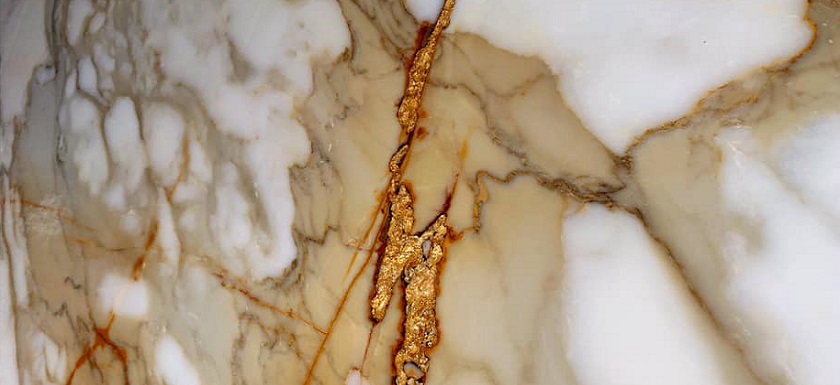
Persa Green Quartzite
Blue and green quartzite worktops seem to be appearing everywhere this year. From high-end restaurants such as Zuaya London to West London and homes in Essex and Surrey, green marble, granite, and quartzite seem increasingly prevalent as worktop materials.
We believe that in 2023 these will also be as prevalent in kitchen worktops, bathroom vanities, and walls. Persa Green quartzite is a unique worktop material with a delicate appearance. Moreover, this green quartzite offers hardness and tenacious performance. In addition, it provides a unique and calm background with various green tones and gorgeous patterning in white, lighter greens, and iron ore. Therefore, a Persa Green quartzite worktop will be ideal if you want a distinct home.
- Thicknesses: 2cm / 3 cm
- Finishes: Polished / Honed
- M2 Price: £269 in 2cm / £359 in 3cm
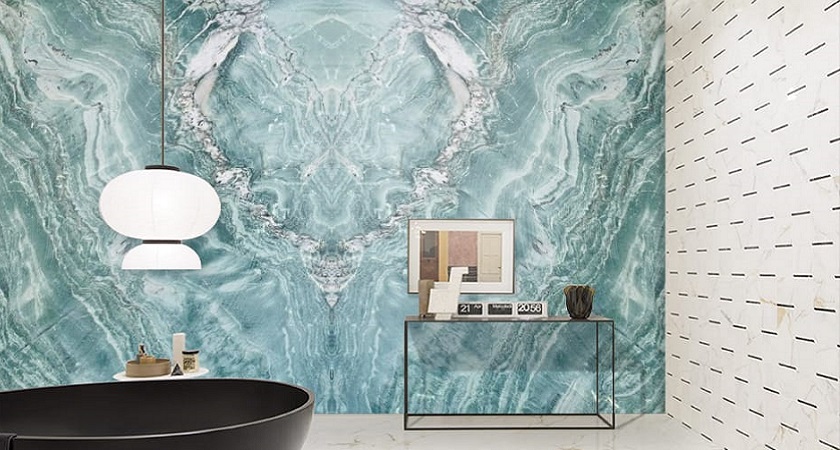
Nuvolato quartzite
Grey serves as the backdrop hue of Nuvolato quartzite with white, dark grey, and brownish hints and veins to make up its unique pattern. This light grey marble is what we call a proper dimensional stone. Additionally, some slabs contain golden-beige touches with a polished finish drawing attention to the marble’s texture. Moreover, distinguished greyish marble from Northern Italy displays streaks of light grey shading with flowing veins in various hues to suit modern and classic interiors.
- Thicknesses:2cm / 3 cm
- Finishes: Polished / Honed
- M2 Price: £228 in 2cm / £309 in 3cm
Conclusion
In conclusion, while marble and quartzite have their unique advantages as kitchen worktops, they also come with a few potential drawbacks that should be considered before making a final decision.
Quartzite is generally more expensive than marble because it is a burdensome stone that requires labour-intensive manufacturing. But both require regular maintenance and upkeep to prevent staining and damage.
In addition, marble is a softer stone and can be scratched or chipped more easily than quartzite. Compared to quartz, both marble and quartzite provide more distinct and natural looks. But quartz is more practical as it does not require maintenance.
Author:

Alan Nussbaum
Meet Alan Nussbaum, our Sales and Marketing Manager. With almost two decades of experience, Alan’s impressive track record includes creating one of the first online stone companies in 2012 and pioneering the acceptance of cryptocurrencies in construction in 2018 before co-founding The Worktop Library with Maria.
Alan’s work is featured in numerous Stone and Home Decor magazines. In addition, he collaborates with the industry’s leading stone brands, cementing his reputation as an innovator.
Before starting a thriving career in the stone industry, Alan honed his skills by overseeing luxury fashion brands such as Burberry, Matches Fashion, and Patrick Cox. With his unique blend of experience and expertise, Alan is a true trailblazer in the stone worktop industry. His passion for delivering exceptional service is evident in every aspect of his work.
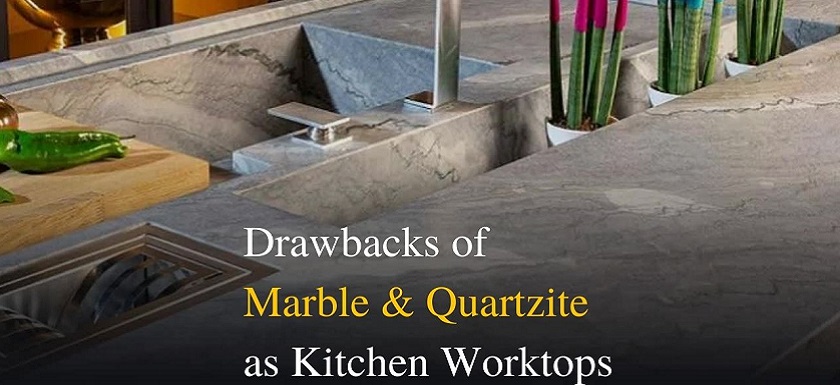
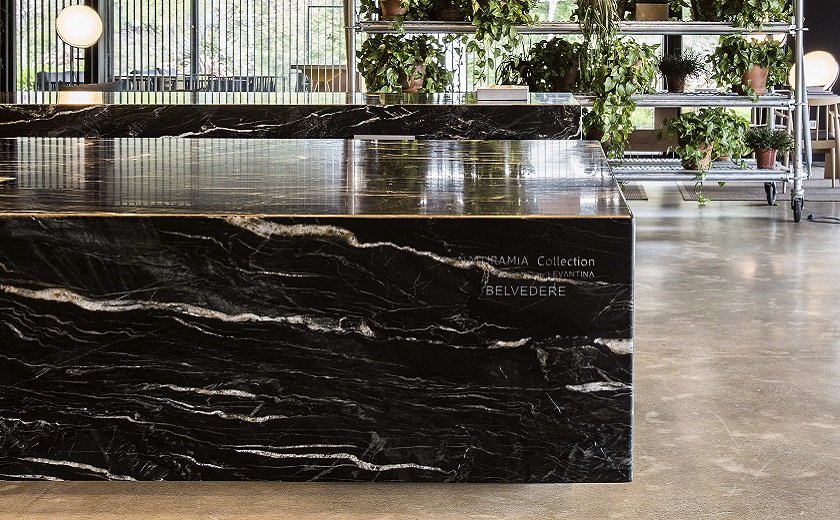
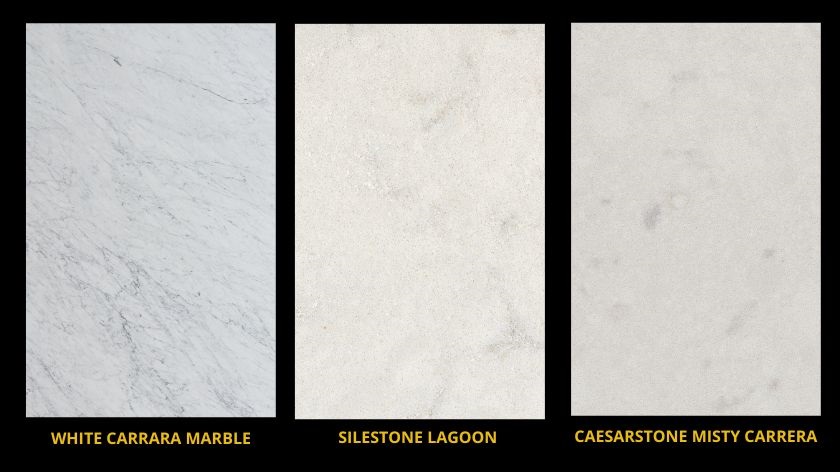
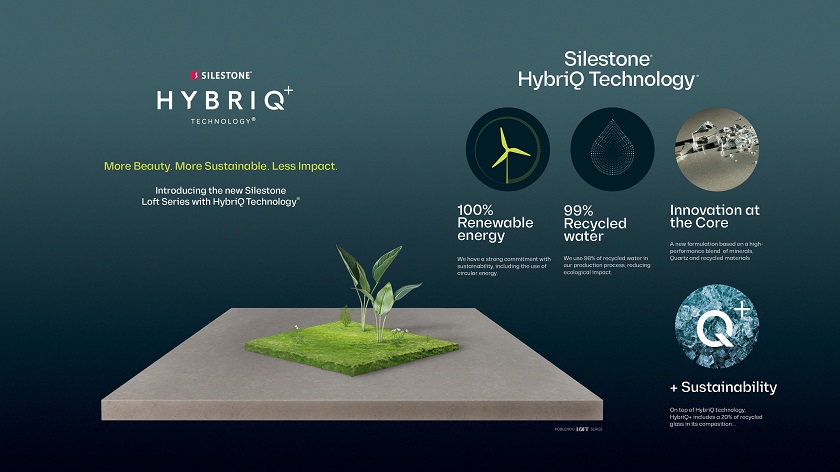
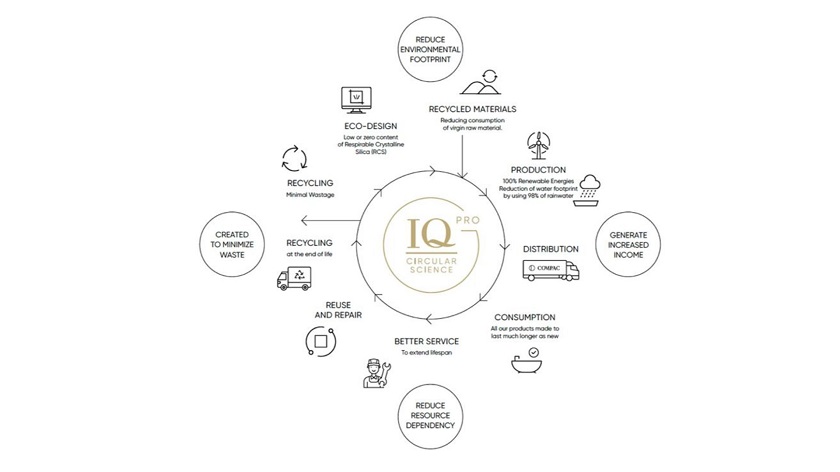
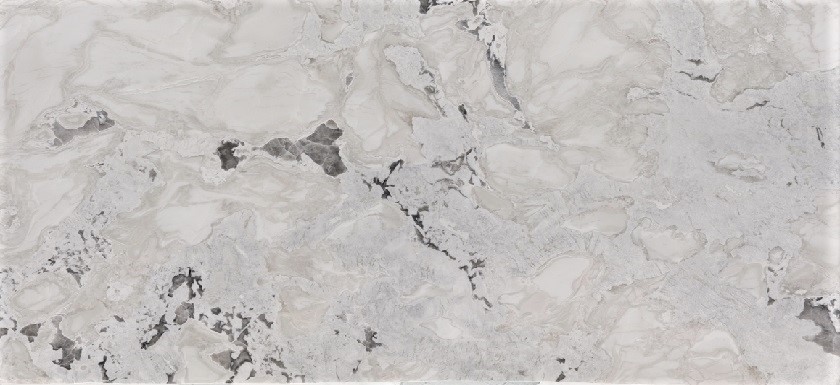
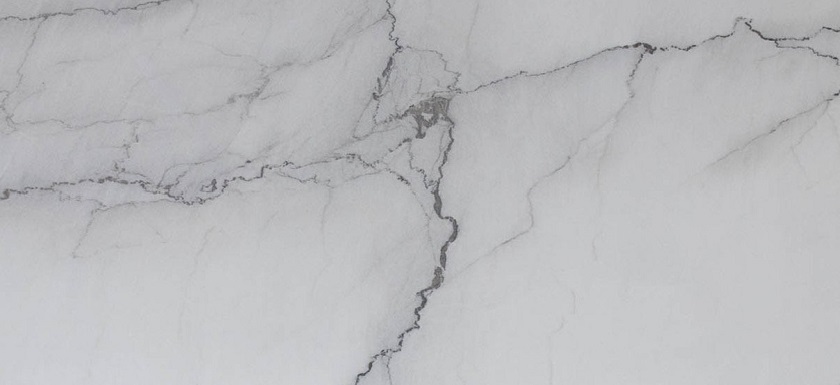
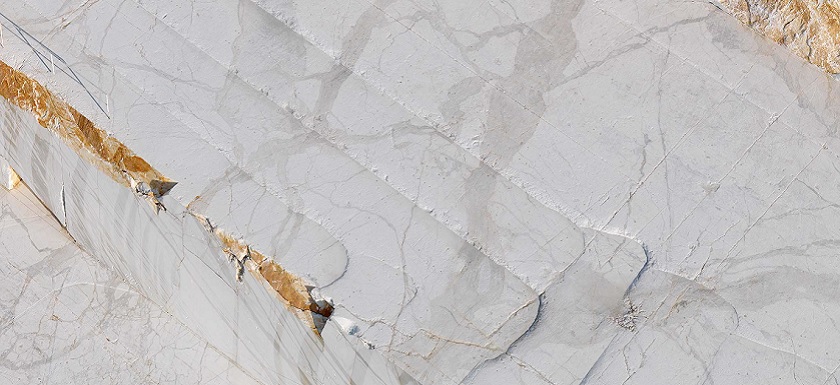
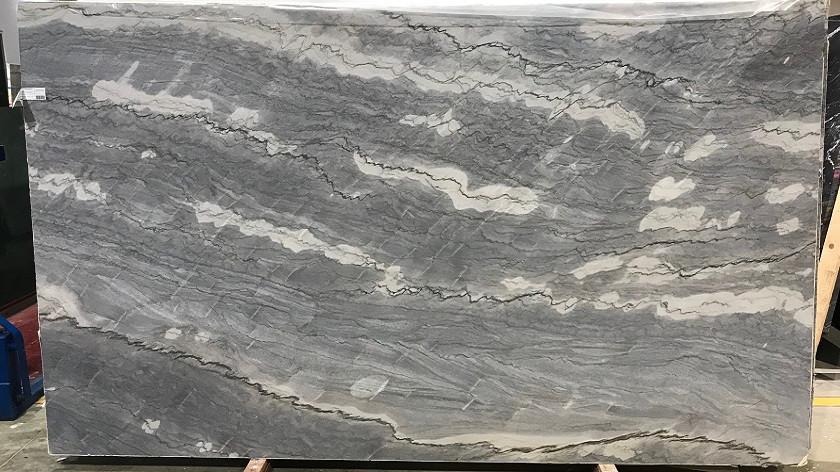
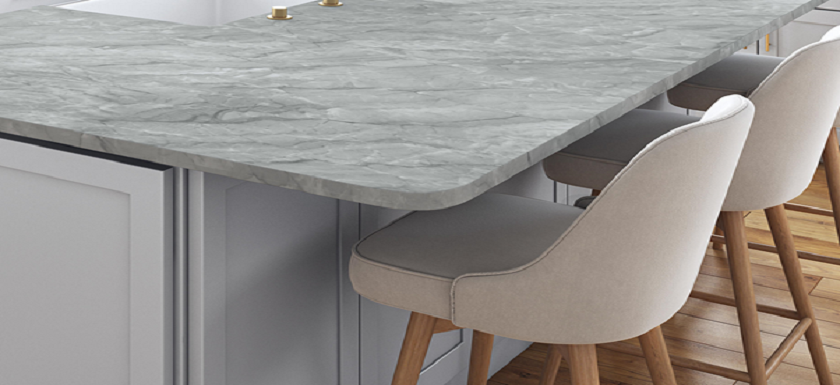 Apr 16 2021
Apr 16 2021 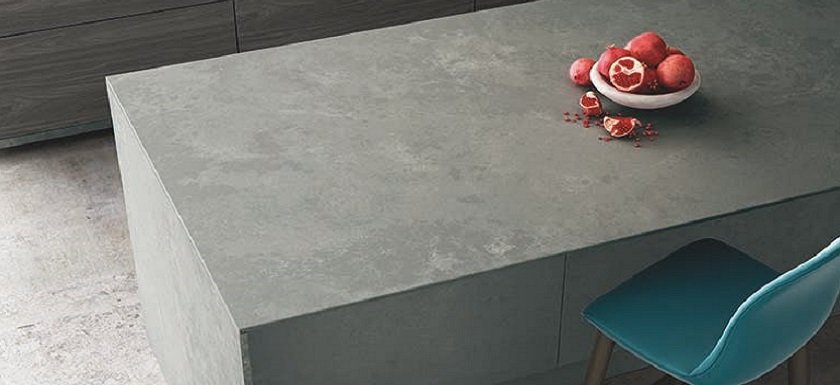 Apr 19 2021
Apr 19 2021  May 05 2021
May 05 2021 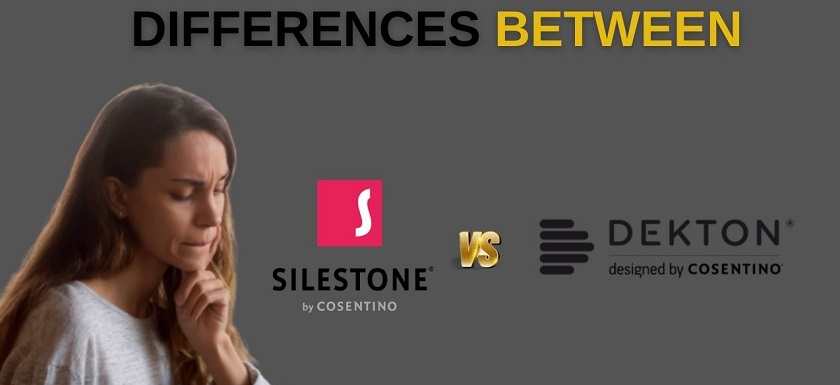 May 07 2021
May 07 2021 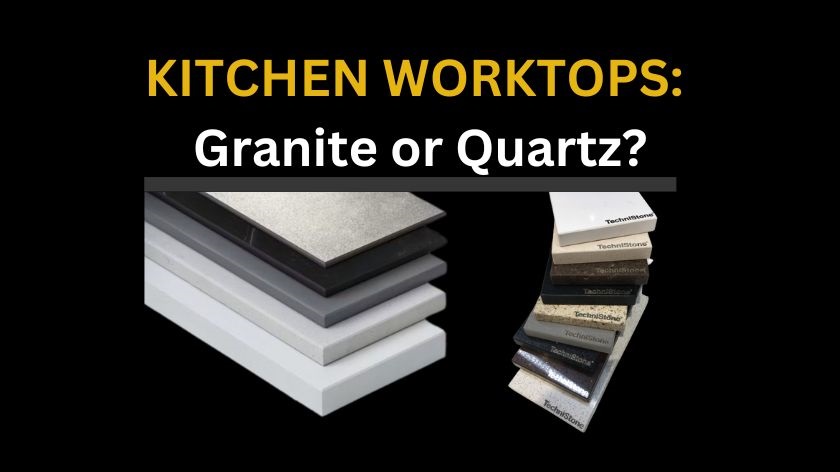 May 15 2021
May 15 2021 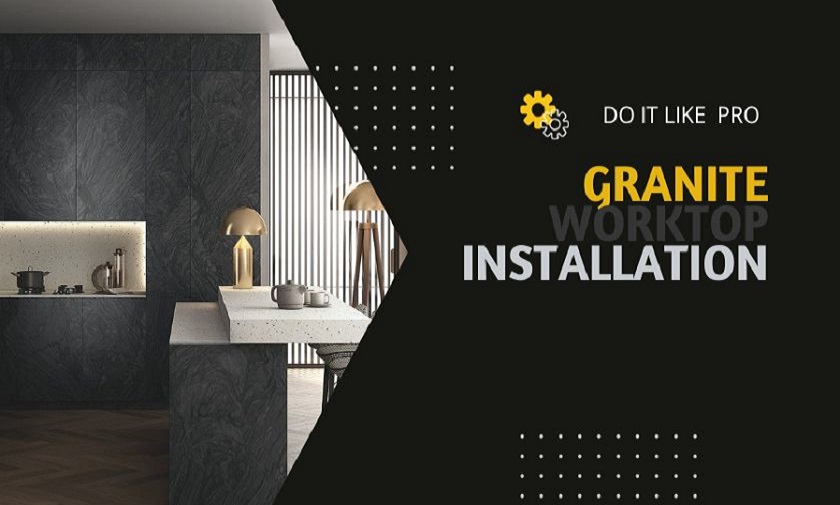 May 17 2021
May 17 2021 